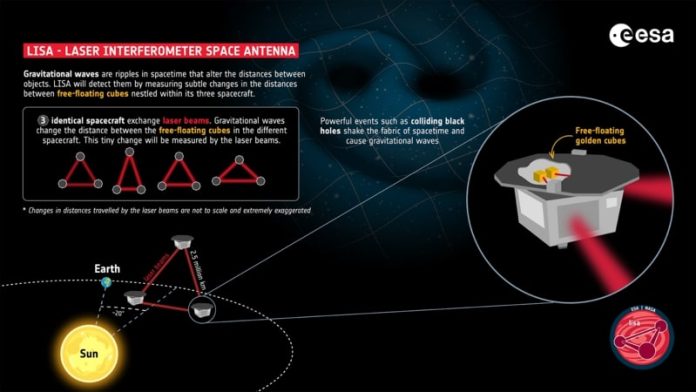The Laser Interferometer space Antenna (LISA) mission has received the go ahead of European space Agency (ESA). This paves the way for developing the instruments and spacecrafts commencing January 2025. The mission is led by ESA and is a result of collaboration between ESA, its Member State prostor agentury, NASA, and an international consortium of scientists.
Scheduled to be launched in 2035, LISA will be the first prostor-na základě gravitační vlna observatory dedicated to detection and study of millihertz ripples caused by distortions in the fabric of prostor-čas (gravitační vlny) přes vesmír.
Unlike the ground based gravitační vlna detectors (LIGO, VIRGO, KAGRA, and LIGO India) which detect gravitační vlny in frequency range of 10 Hz to 1000 Hz, LISA will be designed to detect gravitační vlny of much longer wavelengths in the low frequency range between 0.1 mHz and 1 Hz.
Ultra-nízká frekvence (10-9-10-8 Hz) gravitační vlny (GWs) with wavelengths from weeks to years from supermassive binary černé díry can be detected using ground-based Pulsar Timing Arrays (PTAs). However, low frequency gravitační vlny (GWs) with frequency between 0.1 mHz and 1 Hz can neither be detected by LIGO nor by Pulsar Timing Arrays (PTAs) – the wavelength of these GWs is too long for LIGO and too short for PTAs to detect. Hence, the need for prostor-based GW detector.
LISA will be a constellation of three spacecrafts in accurate equilateral triangle formation in space. Each side of the triangle will be 2.5 million km long. This formation (of the three spacecrafts) will oběžná dráha Sun in an Earth-trailing heliocentric oběžná dráha between 50 and 65 million km from Earth while maintaining a mean inter-spacecraft separation distance of 2.5 million km. This space-based configuration makes LISA an extremely large detector to study low frequency gravitační vlny that ground-based detectors can not.
For detection of GWs, LISA will use pairs of test masses (solid gold-platinum cubes) free-floating in special chambers at the heart of each spacecraft. Gravitační ripples will make extremely small changes in the distances between test masses in the spacecrafts which will be measured through laser interferometry. As demonstrated by LISA Pathfinder mission, this technology is capable of measuring changes in distances to a few billionths of a millimetre.
LISA will detect GWs caused by merger of supermassive černé díry at the centre of galaxies thus will shed light on evolution of galaxies. The mission should also detect the predicted gravitational 'zvonění' vytvořené v počátečních okamžicích vesmír v prvních sekundách po velkém třesku.
***
Reference:
- ESA. Zprávy - Zachycení vln časoprostoru: LISA dostává krok vpřed. Publikováno 25. ledna 2024. Dostupné na https://www.esa.int/Science_Exploration/Space_Science/Capturing_the_ripples_of_spacetime_LISA_gets_go-ahead
- NASA. LISA. Dostupné v https://lisa.nasa.gov/
- Pau Amaro-Seoane et al. 2017. Laser Interferometer space Antenna. Preprint arXiv. DOI: https://doi.org/10.48550/arXiv.1702.00786
- Baker et al. 2019. The Laser Interferometer space Antenna: Unveiling the Millihertz Gravitational Wave Sky. Preprint arXiv. DOI: https://doi.org/10.48550/arXiv.1907.06482
***
***
***






































